It's Samhain time, when Autumn begins to fade toward Winter, and the spirits come to visit the physical world. This was the old Celtic New Year, a celebration of those who have passed on, a celebration of the last of the harvest; in general, a celebration of the glories of Autumn. It was eventually appropriated by the Church and "christianized" to become All Hallows Eve (Halloween). All Saints Day, and All Souls Day. And it's still a celebration of the best that is Autumn. I've posted about this in more detail; to read more just type Samhain in the search box at the top left of this page. For this year, I thought I'd just post some of my favorites among the seasonal photos I've taken through the years. And after you've looked at them I'll hook you up with some of my favorite seasonal music.
 |
| Clifton Burying Ground, Newport, RI |
 |
| A trail in Miantonomi Park in Newport, RI |
 |
| A pair of Mallards on Gooseneck Cove in Newport, RI |
 |
| Extravagance - Ginkgo leaves on King St. in Shippensburg, PA |
 |
| Autumnal reflections on the north duck pond in Dykeman Spring Nature Park, Shippensburg, PA |
 |
| South Mountain from Black Gap Rd., Chambersburg, PA |
 |
| Spring Hill Cemetery in Shippensburg, PA, with South Mountain in the background |
I've created a YouTube playlist of videos of some of my favorite music for the Samhain/Halloween season; click here to check it out. But before you click, here's a list of what you'll find:
1. Camille Saint-Saëns' Danse Macabre in an animation from PBS back in the 1980s. This has become one of my seasonal favorites.
2. All Souls Night, Loreena McKennitt's musical bridge between Samhain and All Souls, another of the songs I listen to this time of year.
3. A-Souling by the now-defunct New Zealand group Lothlorien. Soul cakes and souling (begging for said cakes from house to house) were originally a Samhain and early Halloween tradition before drifting over to Christmas. This tradition transformed into trick-or-treating.
4. Into the West by Howard Shore and Fran Walsh for the soundtrack of Peter Jackson's Lord of the Rings: The Return of the King movie, and performed by Annie Lennox. This is a beautiful setting of Gandalf's description of death as sailing into the afterlife in Tolkien's mythology, and a perfect fit for the theme of Samhain.
5. Tam Lin by Fairport Convention. Tam Lin is one of a collection of old ballads from the British Isles about less-than-savory characters luring innocents into the scarier corners of the afterlife.
6. Thomas the Rhymer, another of those old ballads, this one performed by Steeleye Span .
7. Now we hop over to Halloween, with I Put a Spell On You, a hit for Screamin' Jay Hawkins back in the '50s. But I have a particular fondness for this cover version by Creedence Clearwater Revival.
8. The Monster Mash by Bobby Pickett, a comic Halloween favorite.
9. The original video for Michael Jackson's Thriller, which was actually a short film by John Landis as a tribute to those old, cheesy horror films of the '50s and early '60s. I've never been a big fan of MJ, but this video produced by him and John Landis and Quincy Jones is a classic.
10. Beetlejuice is one of the best of the Halloween comedies, and this scene set to Harry Belafonte's Banana Boat Song has got to be one of the funniest and most fun scene of all time.
11. And last but not least, Time Warp from the Rocky Horror Picture Show. What a hoot!
Enjoy!
© 2018 by A. Roy Hilbinger

































.jpg)

























